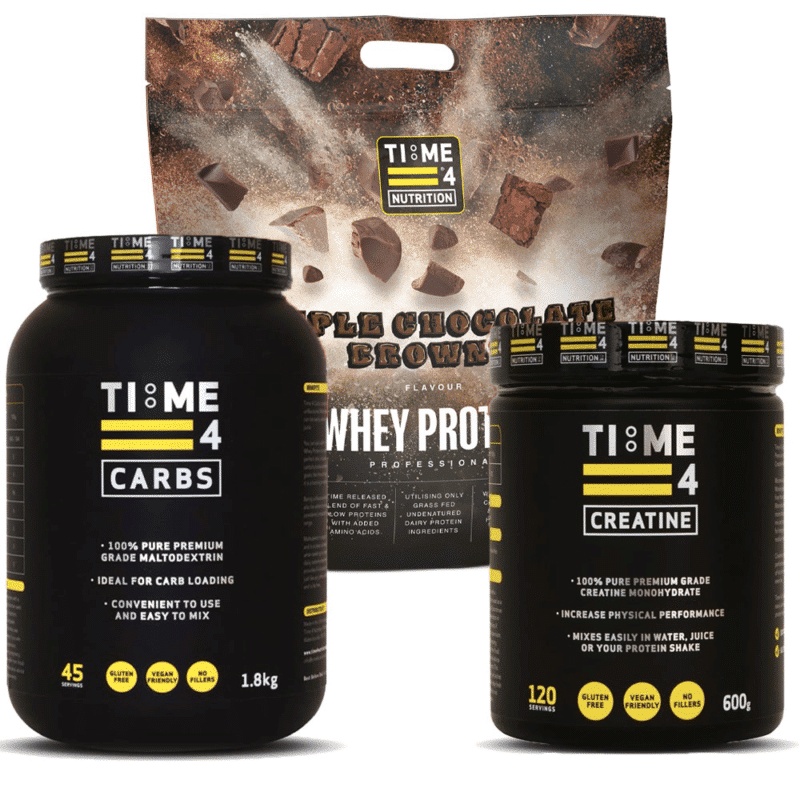THINK YOU KNOW ABOUT TIME 4 MASS GAIN? THINK AGAIN…
Think You Know About Time 4 Mass Gain? Think Again…
What makes the best Mass Gainer?
(Click on the Reference Numbers in Blue for More Info)
You’ll often hear people comment on how difficult it is to lose bodyfat, but in comparison to building lean muscle mass, it’s relatively easy: Simply restricting your calorie intake sufficiently will reduce your levels of body fat. However, gaining lean muscle mass requires the combination of a progressive resistance training programme and a well-planned diet, which provides the requisite levels of the various nutrients and energy to fuel your workouts, support muscle growth and keep you healthy. Two essential elements a mass building diet must provide you with is a protein intake of 2 grams or more of protein per kilo of bodyweight and 44-50kcal kcal of energy per kilo of bodyweight. For example, a 100kg man wishing to increase his muscle mass would need to be consuming somewhere in the region of 200-300g of protein, in addition to 500-600g of carbohydrate and approximately 95g of fat per day.
Building muscle not only requires the consumption of the right amounts and ratios of protein, carbohydrates and fats, but also an increase in daily energy intake to create a surplus above normal daily energy needs. This is because the daily energy cost of just maintaining our existing muscle accounts for approximately 20% of our energy intake. Building new muscle then further increases our energy needs. So, you’ll need to consume somewhere between 350-500 additional kcal per day. Based on 44-50kcal per kilo of bodyweight, our example 100kg man will need to be consuming approximately 4,400-5000 kcal per day.
As you can probably imagine, it would be difficult to consume, digest and metabolise 4000-5000kcal of food in the three standard meals per day typically eaten by the general population. Consequently, you’ll need to break your food intake into 5 or 6 meals consumed throughout the day, approximately 3-4 hours apart.
In theory, you should be able to obtain all of the nutrients and energy you require from food sources. However, in practice this can be difficult if you don’t have a big appetite or if the preparation and consumption of 5 or 6 meals is inconvenient for you.
This is where Time 4 Mass Gain can provide a valuable addition to your diet. Early mass gain supplements were often criticised for being full of ‘empty calories’, i.e., providing calories with little or no nutritional value. However, time and science has moved on since then. Here at Time 4 Nutrition, we pride ourselves on employing the findings of latest cutting-edge research to produce the most effective and innovative products. In this article, we are going to review some of that research and explain how there’s a lot more to Time 4 Mass Gain than the name suggests.
What’s in Time 4 Mass Gain?

Time 4 Mass Gain is a specially formulated blend of whey and micellar casein proteins, waxy maize starch, maltodextrin, flax seed oil, medium chain triglycerides, creatine ethyl ester, creatine gluconate, creatine monohydrate, creatine nitrate and probiotics. As we look at each of these ingredients in-depth, you’ll begin to see why Time 4 Mass Gain is such a great product and how it may benefit you.
What is Whey Protein?
Whey protein is the protein fraction of whey, the liquid portion of milk that separates from the curds during the cheese making process. It comprises 20% of total milk protein and is rich in branch chain and essential amino acids, functional peptides, antioxidants and immunoglobulins (17).
It is a complete, high-quality, easily digested protein which has been shown scientifically to provide numerous potential benefits for health and performance. These include increasing muscle mass (1, 12, 15, 16,), reducing body fat (1, 2, 4), helping to maintain muscle mass during weight loss (4), suppressing appetite to aid fat loss, increasing metabolism (2), improving immune function, reducing blood pressure (5), reducing unhealthy blood fats (7), improving blood glucose levels in type 2 diabetics, and increasing the production of glutathione, the body’s master antioxidant(8). It also confers benefits against a wide range of metabolic diseases such as cardiovascular complications, high blood pressure, obesity, diabetes, cancer and phenylketonuria (17).
How Does Whey Protein Compare to Other Proteins?
Having reviewed the data supporting the role for whey protein consumption in the regulation of muscle mass and body composition, Devries and Philips (18) concluded that whey protein is one of the highest-quality proteins, given its amino acid content (high essential amino acids, branch chain amino acids, and leucine amino acid content) and rapid digestibility. They further suggest that whey protein has the ability to stimulate muscle protein synthesis to a greater degree than other proteins.
Is It Just the Young and Athletic Who Can Benefit from The Consumption of Whey Protein?
Camargo and colleagues (19) conducted a systematic review of 35 research papers to evaluate the consumption of whey protein for the elderly and the association with physical performance and clinical outcomes. The results of the review suggest that whey protein supplements promote protein synthesis in the elderly, improving muscle performance and aerobic capacity, protecting against sarcopenia and reducing the risk for falls. Whey protein also appears to contribute to improved health, recovery from disease, prevention of cardiovascular and metabolic risks, and hepatic steatosis complications.
Are All Whey Proteins the Same?
There are various types of whey protein, which differ slightly in the processing they have undergone, their composition and the benefits they provide.
Time 4 Mass Gain is a blend of low temperature undenatured whey protein concentrate and whey protein isolate.
Low temperature undenatured whey protein concentrate is a form of whey protein typically low in fat and cholesterol, containing bioactive compounds as well as growth factors and small amounts of carbohydrates in the form of lactose, and is quickly absorbed by the body. It is also rich in both branch chain amino acids (BCAAs) and glutamine. We’ll look at BCAAs and glutamine in some detail a little later.
The term ‘undenatured’ means that the whey is cold processed, rather than being heated to high temperature, allowing it to maintain all of its amino acids. The bioactive compounds and growth factors contained within whey protein concentrate provide significant health benefits but must remain in their undenatured form in order to exert these properties.
Low temperature undenatured whey protein isolate is a form of whey protein, which has undergone greater processing than whey concentrate. This results in a reduction in some bioactive compounds and growth factors, but provides a greater protein content and lower levels of carbohydrates, lactose and fat than whey concentrate. It is also more quickly absorbed by the body than whey protein concentrate.
What Is Micellar Casein Protein?
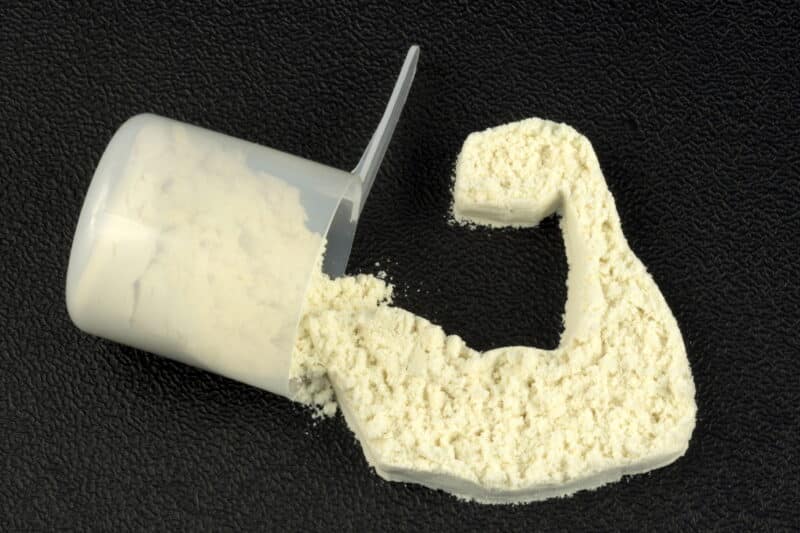
In addition to whey, Time 4 Mass Gain also contains Low Temperature Undenatured micellar casein Protein.
While whey comprises 20% of milk protein, casein accounts for the remaining 80%. Like whey protein, casein is a complete protein which provides all of the essential amino acids the body needs for growth and repair (9).
There are two main forms of casein protein. These are casein hydrolysate, which is pre-digested and rapidly absorbed, and micellar casein.
In contrast to whey protein’s rapid digestion, micellar casein protein is referred to as a ‘time-release’ protein because it is digested slowly, feeding your muscles with amino acids at a low level over a period of up to 8 hours after consumption to ensure optimum growth and recovery (10, 11).
This makes it ideal to take before bed when it can reduce muscle breakdown as you fast overnight. In short, this means that your muscle cells are able to synthesize protein during times when your body might normally be breaking down its own muscle tissue. Consequently, this ability of micellar casein protein has led to it being referred as ‘anti-catabolic’.
However, it is important to note that micellar casein protein isn’t just for consumption at night; it can provide its valuable time release benefits any time of the day. For example, you may not be able to consume high quality protein every 3-4 hours due to the restrictions of a busy work or life schedule. In these situations, micellar casein protein can provide you with that vital supply of essential amino acids for longer periods.
Just How Effective Is Consuming Casein Protein Before Bed?

A study by Snijders and colleagues (20) assessed the impact of casein protein supplementation before sleep on muscle mass and strength gains during a resistance training programme. The results of the study showed that those subjects consuming a casein protein supplement before bed increased type 2 muscle fibre size by 8.4cm2 compared to 4.8 cm2 in the placebo group. The study also found the casein group achieved significantly greater gains in strength (20%) in comparison to the placebo group.
In light of evidence such as this, the International Institute of Sports Nutritionists now recommend a pre-sleep intake of casein protein to increase overnight muscle protein synthesis (21).
How will Micellar Casein Protein Benefit Me?
Micellar casein protein is very effective for promoting muscle growth and strength, as it not only provides all of the essential amino acids, but also contains a high level of leucine, which initiates muscle protein synthesis (12, 13, 14). It may also enhance long-term muscle mass by reducing protein breakdown (10, 11). This process occurs on a daily basis when your body is low on energy and amino acids, and is accelerated during exercise or weight loss.
In addition to increasing muscle mass, casein protein has also been shown to help reduce body fat levels (14).
For example, a study by Demling and DeSanti (14) compared the effects of a moderate hypo-caloric, high-protein diet and resistance training, using two different protein supplements, versus hypo-caloric diet alone on body compositional changes in overweight police officers. The results of the study showed that the casein protein group’s fat loss was three times greater than the placebo group.
Lean mass gains in the three groups did not change for diet alone, versus gains of 4 +/- 1.4 and 2 +/- 0.7 kg in the casein and whey groups, respectively. Mean increase in strength for chest, shoulder and legs was 59 +/- 9% for casein and 29 +/- 9% for whey. The authors concluded that this significant difference in body composition and strength is likely due to improved nitrogen retention and overall anticatabolic effects caused by the peptide components of the casein protein.
In addition to enhancing muscle mass and reducing body fat, casein protein has been shown to provide a number of other potential health benefits. These include, but are not limited to, reducing blood triglyceride levels (22), reducing free radicals (23), and enhancing immune function (24).
Note: The Micellar Casein protein used in Time 4 Mass Gain is low temperature undenatured, allowing it to maintain all of its amino acids, bioactive compounds and growth factors in their most powerful natural state.
Combining Whey and Casein Protein: What Does the Science Say?
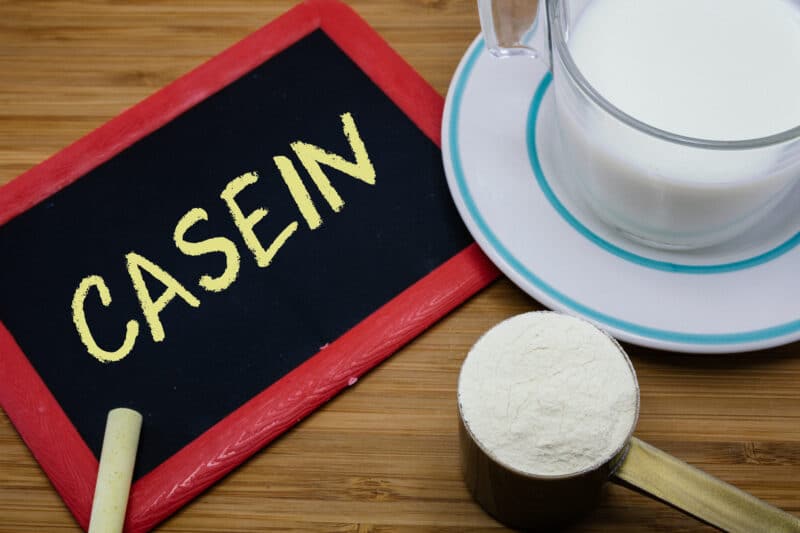
We have seen that both whey and casein protein can provide numerous benefits but is there additional benefit to be gained from combining them?
The speed of absorption of dietary amino acids by the gut varies according to the type of ingested dietary protein, which can affect post-feeding protein synthesis, breakdown, and deposition. To test this hypothesis, Boirie et al., (10) had a group of healthy adults consume a casein and whey protein supplement in a single meal.
The results showed that whey protein induced a dramatic but short increase of plasma amino acids, while casein protein induced a moderate increase with a prolonged plateau. Whole body protein breakdown was inhibited by 34% after casein protein ingestion but not after whey protein ingestion. Postprandial protein synthesis was stimulated by 68% with the whey protein meal and to a lesser extent (+31%) with the casein.
The authors concluded that the speed of protein digestion and amino acid absorption from the gut has a major effect on whole body protein anabolism after a single meal. Therefore, the body’s response to slow and fast proteins has implications for both health and performance.
The bottom line is that a combination of the both whey and casein protein provides a better anabolic effect as it delivers a sustained feed of muscle building amino acids into the blood stream to ensure optimum growth and recovery.
Time 4 Complex Carbohydrate Blend
Time 4 Mass Gain contains a complex carbohydrate blend of slow releasing waxy maize starch and fast acting maltodextrin to provide you with a sustained supply of carbohydrates to aid high intensity training, recovery and muscle growth.
What is Waxy Maize Starch?
Waxy maize starch, also known as waxy corn starch, contains no wax, but appears waxy when viewed under a microscope. It is considered to be superior to many other varieties of corn or maize due to its high amylopectin content, a type a polysaccharide which gets absorbed more slowly by the body and is easily converted to glycogen to supply working muscles with energy during exercise.
How will Waxy Maize Starch Benefit Me?
It has been proposed that waxy maize starch can boost energy levels and endurance to allow longer more effective workouts and reduce recovery time.
For example, a study by Roberts et al., (25) showed that ingestion of waxy maize starch before prolonged exercise blunted the initial spike in blood glucose and insulin and increased the breakdown in fat to fuel extended exercise.
Sands and colleagues (26) hypothesized that the waxy maize treatment would result in a blunted and more sustained glucose and insulin response. The results of the study showed that waxy maize led to lower 4 hour glucose and insulin responses compared to a control carbohydrate source. The authors concluded that waxy maize provides sustained glucose availability in young, insulin sensitive adults.
What is Maltodextrin?
Maltodextrin is an easy-to-digest complex carbohydrate made from corn, potato or rice starch, which can provide a rapid supply of energy. It is often contained in sports drinks to allow athletes to refuel and rehydrate simultaneously during exercise, as it is absorbed as rapidly as glucose. It can also provide the additional calories required to increase muscle mass, in addition to various other benefits.
How Will Maltodextrin Benefit Me?
The use of maltodextrin supplementation is supported by a number of scientific studies, which demonstrate the wide variety of performance benefits it can provide. These include increasing muscle protein synthesis, resulting in greater muscle hypertrophy and strength (27), improving anaerobic power (28) improving endurance performance (29,30) and enhancing post-exercise recovery (30)
A study by Hosseni and Nakhostin-Roohi (28) found that supplementation with a combination of the amino acid glutamine and maltodextrin, before exercise helped to prevent a decrease in anaerobic power in repeated bouts of sprinting.
Restoring the body’s stores of glycogen during recovery from prolonged exercise is essential if you wish to maximise performance in repeated exercise bouts. Maunder and colleagues (30) investigated the effects of post-exercise maltodextrin and fructose ingestion on subsequent exercise performance. The results of the study showed that short-term recovery of endurance capacity was significantly enhanced with maltodextrin and fructose ingestion during recovery.
Combining Carbohydrates and Protein: What does the science say?
Perhaps there is a tendency to think of protein building muscle and carbohydrates supplying energy to train, but protein can provide us with energy during exercise and carbohydrate plays an important role in building muscle. For example, Stark et al., (27) conducted a review of the literature on protein timing and its effects on muscular hypertrophy and strength in individuals engaged in weight-training. They concluded that combination of a fast-acting carbohydrate source such as maltodextrin should be consumed with the protein, as leucine, the amino acid which drives muscle growth, cannot modulate protein synthesis as effectively without the presence of insulin to transport it into the muscle cells.
A study by Ivey et al., demonstrated that a combined protein and carbohydrate supplement is also more effective for the rapid replenishment of muscle glycogen after exercise than carbohydrate alone (31). Evidence such as this has led the International Institute of Sports Nutritionists to recommend combining protein with carbohydrate when trying to rapidly restore glycogen levels, as well as promoting muscle protein synthesis (32).
What is Flaxseed Oil?
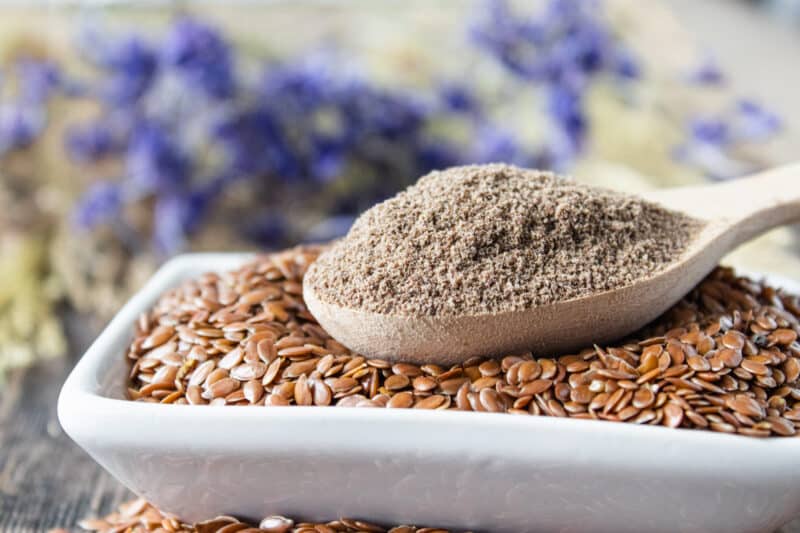
Flaxseed oil is a colourless to yellowish oil obtained from the dried, ripened seeds of the flax plant. It has high content of omega-3 fats, fibre, and other unique plant compounds.
How Will Flaxseed Oil Benefit Me?
Flaxseed oil has been linked to various benefits, such as increased testosterone levels, enhanced recovery from exercise, improved digestion and a reduced risk of heart disease, and type 2 diabetes.
It is a source of omega 3 polyunsaturated fatty acids, which have been the subject of considerable research. For example, a review by Philpott et al., (33) investigated the applications of omega-3 polyunsaturated fatty acid (n-3PUFA) supplementation for sport performance. The authors concluded that n-3PUFA supplementation may promote post-exercise recovery from eccentric-based muscle damaging exercise, such as resistance training, and improve endurance capacity by reducing the oxygen cost of exercise.
What are Medium Chain Triglycerides (MCTs)?
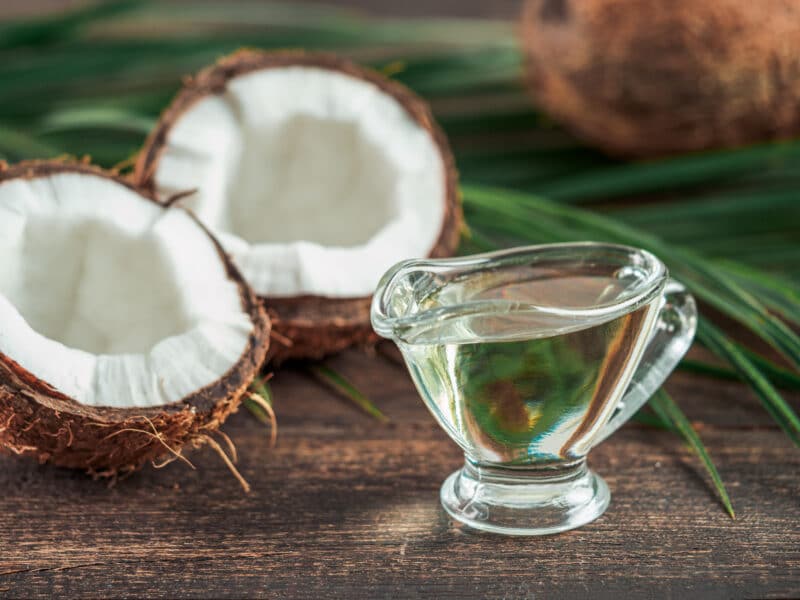
Medium chain triglycerides (MCTs) are partially man-made fats, but also occur in natural sources, such as coconut oil and dairy fat. They are a form of saturated fatty acid which are known to be digested and used to supply energy for activity more readily and completely than long-chain triacylglycerols (LCT). Therefore, they are less likely to be stored as body fat.
How Will Medium Chain Triglycerides (MCTs) Benefit Me?
Medium chain triglycerides have numerous benefits, ranging from increasing muscle mass and exercise performance and reducing body fat to improving cognitive function and reducing anxiety. MCTs have also been shown to provide a steady supply of energy that helps to prevent blood sugar swings while sleeping and so improve sleep quality and decrease the chances of waking due to low blood sugar levels.
A study by Nosaka et al., (34) assessed the effect of MCTs on moderate and high intensity exercise. The results of the study showed that the short-term ingestion of food containing a small amount of MCT suppresses the increase in blood lactate concentration and RPE during moderate intensity exercise and extends the duration of subsequent high-intensity exercise.
Abe and colleagues (35) investigated the effects of MCTs on muscle strength and function and the activities of daily living (ADL) in elderly individuals. The authors concluded that MCTs can increase muscle strength and function of these individuals and also improve their ADL
What is Creatine?
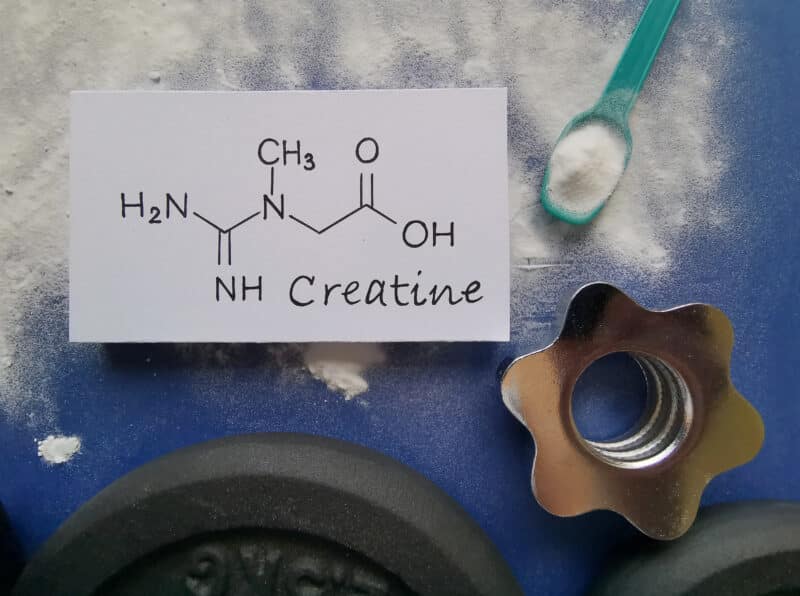
Creatine is a substance that is produced naturally in the body. Approximately 5% is found in the brain, kidneys and liver. The remaining 95% (120-140g) is stored in our skeletal muscle, where it forms a high-energy molecule known as phosphocreatine. It is the breakdown of phosphocreatine which produces ATP (adenosine triphosphate) to fuel the muscles during heavy lifting and high intensity exercise. ATP is depleted rapidly during strenuous activity. Therefore, using a creatine supplement to increase our stores of phosphocreatine helps the body to produce greater amounts of ATP. This enables our muscles to resist fatigue and maintain a higher level of performance for longer during intense exercise. The greater the amount of ATP a muscle has, the greater the force and number of contractions it can produce before it becomes fatigued. Consequently, athletes and bodybuilders have been using creatine supplements to enhance performance for many years.
How Will Creatine Benefit Me?
The use of creatine supplementation is supported by numerous scientific studies which demonstrate the wide variety of performance and health benefits it can provide. These include, but are not limited to:
- Increasing muscle size, strength and power (36, 37, 38, 39)
- Increasing muscular performance (peak power) during high-intensity resistance training (36, 38, 39)
- Decreasing levels of myostatin, a molecule responsible for inhibiting muscle growth (40)
- Increasing the water content of muscle (volumization) which can quickly increase muscle size (41)
- Increasing levels of the anabolichormone IGF-1 (42)
- Improving single and repetitive sprint performance (43, 38)
- Reducing fatigue(44)
- Enhancing glycogen synthesis(36)
- Increasing anaerobic threshold(36)
- Increasing work capacity (36, 38)
- Enhancing recovery (36)
- Increasing training tolerance (36)
- Possibly enhancing aerobic capacity via greater shuttling of ATP from mitochondria (36).
- Improving control of blood sugar levels (45, 46)
The International Society of Sports Nutrition position stand states that creatine is the most effective ergogenic nutritional supplement currently available to athletes in terms of increasing high-intensity exercise capacity and lean body mass during training. It is one of the world’s most tested supplements and has an outstanding safety profile. Not only is it safe, but has been reported to have a number of therapeutic benefits in healthy and diseased populations ranging from infants to the elderly (36).
Note: If you are a vegan or vegetarian, you are likely to gain even greater benefit from creatine supplementation. As the richest natural sources of creatine are meat, fish and poultry, those eating a plant-based diet tend to have reduced levels. However, when their diet is supplemented with creatine, they retain greater amounts than those consuming meat and fish (36).
What Blend of Creatine is Used in Time 4 Mass Gain?
Time 4 Mass Gain contains an advanced blend of 4 types of creatine each with its own benefits that work synergistically to give you the best results possible. These are:
Creatine Ethyl Ester
Creatine ethyl ester combines creatine with an ester molecule. Esters are organic compounds that help to transport creatine across the lipid membranes of the gut into the bloodstream for delivery to the muscles.
Creatine Gluconate
Creatine gluconate is essentially a creatine molecule bound to a glucose molecule. This enables the more rapid uptake of the creatine by the muscles.
Creatine Monohydrate
Creatine monohydrate is the form of creatine which is most similar or identical to the creatine produced by the body. It consists of creatine with one molecule of water attached to it.
Creatine Nitrate
Creatine nitrate comprises creatine bound to a nitrate group, which increases its water solubility making it more palatable when consumed.
Combining Creatine and Whey Protein: What does the science say?
It’s not by chance that Time 4 Mass Gain contains both whey protein and creatine. The science shows that combining creatine and protein provides superior results to consuming either nutrient alone. For example, Burke and colleagues (47) investigated the effect of whey protein supplementation with and without creatine combined with resistance training on lean muscle mass and strength. The results of the study showed that subjects who supplemented with a combination of whey protein and creatine had greater increases in lean tissue mass and bench press strength than those who supplemented with only whey protein or placebo.
What Are Probiotics (Lactobacillus Coagulans)?

Probiotics are live bacteria, sometimes referred to as ‘good’ or ‘friendly’ bacteria, and yeasts that provide a number of health benefits, especially for the digestive system (48). Lactobacillus is a probiotic bacteria that occurs naturally in the human gut and other parts of the body, and can be found in fermented foods, yogurt and supplements.
How Will Probiotics Benefit Me?
Probiotics can provide various health benefits including helping to keep the gut healthy, aiding digestion and boosting immune function (48).
To Sum Up…
We have seen that Time 4 Mass Gain provides you with a combination of high-quality ingredients which have been shown to aid the development of lean muscle mass thorough directly stimulating muscle protein synthesis and fuelling the high intensity training needed to instigate muscle growth. Just one scoop in 500ml of skimmed milk will not only provide you with all of muscle building nutrients discussed in this article, but also 406 kcal, which is precisely in the range of additional daily energy intake needed to create the surplus above normal daily energy needs required for building muscle. If you require a greater intake, simply use two scoops.
You may still be thinking do I really need Time 4 Mass Gain? As we said at the beginning of this article, it is possible for you to obtain all of the nutrients contained in Time 4 Mass Gain from your diet, although not in such a concentrated form, but it can be challenging and inconvenient to prepare and consume such a potentially large amount of food throughout the day in 5 or 6 meals. Time 4 Mass Gain won’t replace a nutritious diet, but it can be a valuable addition by providing you with a great tasting, easy to consume and convenient way to obtain those additional nutrients and energy required to build lean muscle mass.
